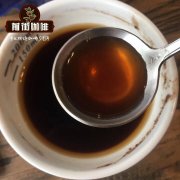What are blended coffee beans? What is the proportion of Italian coffee beans? Which kind of beans should be used to mix coffee beans?

Professional coffee knowledge exchange more coffee bean information please follow the coffee workshop (Wechat official account cafe_style)
What are blended coffee beans? What is the proportion of Italian coffee beans? What kind of beans should I use to mix coffee beans?
Since it is a blending, it naturally refers to the blending of more than two kinds of raw beans, but a special example is that it can also match the same kind of coffee beans with different roasting degrees, or even the new crop and aged coffee or old crop of the same kind of coffee beans, so the type referred to in the blending is no longer a coffee variety in a narrow sense, but extends to the flavor of coffee in a broad sense. As the name implies, individual coffee is made up of beans from a single origin, which is generally drunk directly from black coffee; blended coffee is made up of coffee from different areas in proportion and is generally used to make espresso.
Blending coffee is not a random mix of coffee beans. Sometimes the blending of two kinds of boutique coffee will suppress each other's unique flavor; blending is not simply blending several kinds of boutique coffee together. Matching is like the painter adjusting and creating charming colors in the color palette, the mixer can reconcile the attractive taste according to the different characteristics of the coffee beans.
Individual coffee actually refers to a single type of coffee that comes from a certain producing area or manor of a certain country. Coffee is produced all over the world, so the flavor of coffee beans will also be different from the climate of the producing area and the cultivated soil. generally speaking, the source of coffee is a selection point of individual coffee, and there is also a difference in baking technology and degree.
The coffee beans of individual coffee need to rely on the baker to bring out the flavor of the coffee beans, but this part of the flavor will have the preference of the baker himself, for example, some bakers will like the sour flavor, so there will be differences in sour taste compared with other similar types of coffee.
If you want to drink coffee beans closer to the flavor of the place of origin, you can choose light or medium culture in the degree of baking, which will better show the special taste of the original place of origin, of course, in addition to the origin, the way of baking and the preferences of the bean baker. there will also be differences in taste in brewing equipment.
The reason why coffee is divided into blends and individual products is determined by the combination of coffee beans. Different blending methods bring different flavors, and individual coffees from different regions bring different flavors. These changes may be the charm of coffee, bringing you a new taste experience from time to time.
Comprehensive coffee bean blending skills:
If only a single product of coffee beans is very monotonous, so it must be combined with several kinds of coffee beans to achieve the taste after blending. If there is an error in the selection of the portion of beans during blending, it will cause the advantage of restraining the original beans and deviate their flavor characteristics.
The so-called coffee blending is not simply mixing several kinds of coffee beans together, but making use of the unique flavor of several different coffee beans to make them more harmonious, which is the most important detail of blending coffee bean ratio. In addition to the unique flavor of each kind of coffee, it can also be fried with different tastes according to the difference of roasting degree. Coffee beans of the same quality have a sour taste, while deep-fried coffee beans are bitter and strong, so when you mix them, you must choose the kind of coffee beans to mix. Such a harmonious match also depends on the degree of baking of the ingredients.
For general coffee blending, in addition to the main coffee beans, you only need to mix two or three kinds of coffee beans with characteristics. The most common blending methods are three, but at least two, up to five, too much will cause an imbalance in the original taste.
Comprehensive coffee blending improvement:
In the process of blending, if there are the following problems, the improved formulations are as follows:
1. More bitter coffee: mix 10% Colombian coffee beans to improve the taste.
two。 More wild sour coffee: just mix 10% Romsda or Manning.
3. Low-sour coffee: add 10% manning (stir-fry).
4. Coffee with low flavor: Manning with 10% blending.
Reference of matching proportion and common formula
The formula of mixed beans is not fixed, although it can be mixed according to individual taste, but it is necessary to master the fragrance characteristics of different kinds of beans in order to make delicious mixed beans.
Generally speaking, mixed beans are mainly mixed with 5 varieties, but for beginners, mixing less than 3 kinds first is easier to succeed, and it is better to increase the raw beans (or coffee beans) that want to emphasize the taste to more than 30%.
The golden ratio in the matching world-7:3
It is said that this is the secret recipe of a large international roasting company, as long as it is a mixture of two different coffee beans, the best flavor ratio is almost 7:3 (not if the flavor is too different). If there are three, try 7:2:1 or 6:2:2.
Qianjie recommended matching formula:
(1) Qianjie Italian match No. 2: Colombia: Brazil, proportion 3100% Arabica, flavor characteristics: comfortable sweet and bitter taste, extremely smooth entrance; with light grassy aroma, slightly bitter fragrance; smooth and smooth finish. Using medium-deep baking, when concentrated, the taste will be soft, slightly sour, sweet, nutty, the overall feeling will not be too exciting, peaceful, grease belongs to medium.
(2) Commercial matching:
Colombia: Brazil: Robusta; ratio 3:6:1, life
In terms of the flavor of individual beans, the taste of coffee obtained from commercial beans is much lower than that of high-quality coffee beans. generally, commercial beans will choose to be used for blending, and after mixing beans, they can also make coffee with good export flavor, which can be used to make lattes. Cabo and other espresso. And our commercial mix to make Espresso, because there are robusta beans, oil will be richer, taste classic, caramel sweet, nut and cocoa, dark chocolate flavor, sweet and sour balance, a little bittersweet, long-lasting.
(3) basic matching:
Yunnan AA: Brazil; ratio 3:7, cooked; with soft fruit acid, caramel sweetness, nutty, dark chocolate flavor, smooth and sticky, but light.
In fact, the addition of Robusta beans to some Italian concentrated recipes can bring more caffeine, better fat and taste balance. For commercial spells with Luodou, 100% Arabica [boutique Italian # 2] actually contains less than 10%. If you can't drink milk coffee, the overall fat of the coffee will be greatly increased.
Important Notice :
前街咖啡 FrontStreet Coffee has moved to new addredd:
FrontStreet Coffee Address: 315,Donghua East Road,GuangZhou
Tel:020 38364473
- Prev

Geography of Rwandan coffee beans what are the varieties of Rwandan coffee? Rwandan coffee flavor
Professional coffee knowledge exchange more coffee bean information please follow the coffee workshop (Wechat official account cafe_style) Rwanda coffee growing environment Rwanda is located in the heart of the interior of Africa, its mountain terrain is fertile land, as well as ancient traditional bourbon species, indicating that the natural environment needed to grow quality coffee beans can be found everywhere in Rwanda. Coffee was made in Germany in 1904.
- Next

How about traditional Italian coffee blends? Is it okay to mix coffee beans for hand brewing?
Professional coffee knowledge exchange More coffee bean information Please pay attention to coffee workshop (Weixin Official Accounts cafe_style) How about traditional Italian coffee formula? Is it okay to make espresso beans by hand? Coffee blending refers to mixing two or more different varieties of coffee or the same variety of coffee but different degrees of roasting coffee according to a certain proportion. mixed
Related
- Detailed explanation of Jadeite planting Land in Panamanian Jadeite Manor introduction to the grading system of Jadeite competitive bidding, Red bid, Green bid and Rose Summer
- Story of Coffee planting in Brenka region of Costa Rica Stonehenge Manor anaerobic heavy honey treatment of flavor mouth
- What's on the barrel of Blue Mountain Coffee beans?
- Can American coffee also pull flowers? How to use hot American style to pull out a good-looking pattern?
- Can you make a cold extract with coffee beans? What is the right proportion for cold-extracted coffee formula?
- Indonesian PWN Gold Mandrine Coffee Origin Features Flavor How to Chong? Mandolin coffee is American.
- A brief introduction to the flavor characteristics of Brazilian yellow bourbon coffee beans
- What is the effect of different water quality on the flavor of cold-extracted coffee? What kind of water is best for brewing coffee?
- Why do you think of Rose Summer whenever you mention Panamanian coffee?
- Introduction to the characteristics of authentic blue mountain coffee bean producing areas? What is the CIB Coffee Authority in Jamaica?

